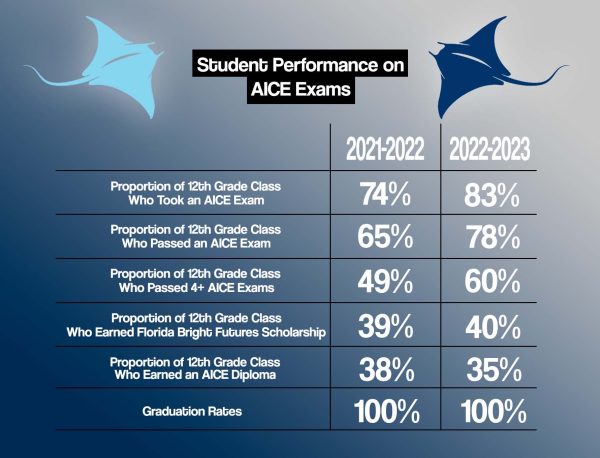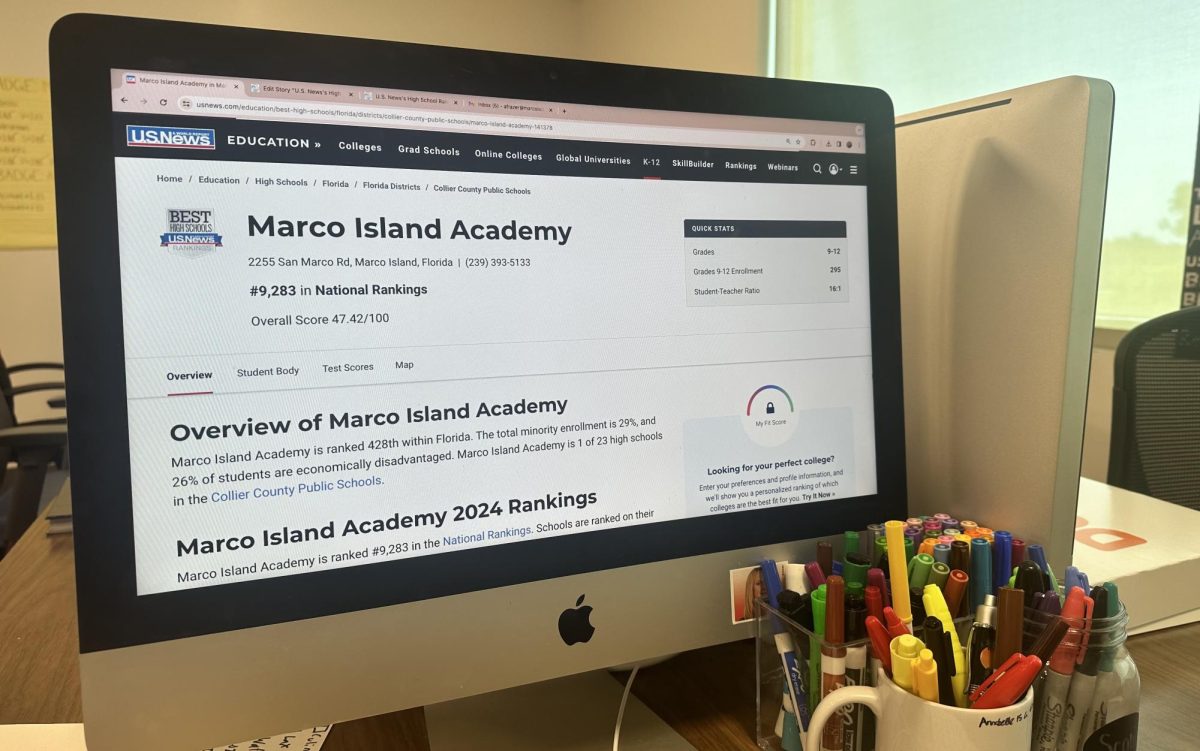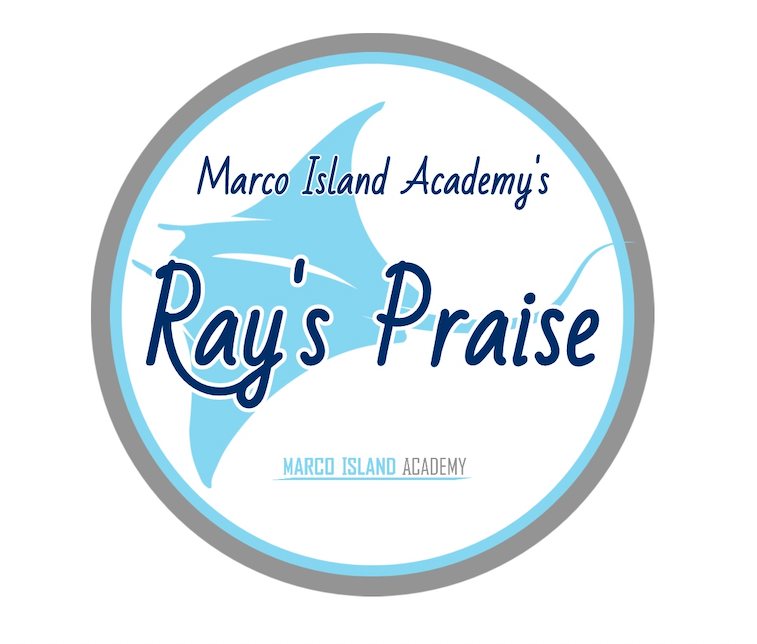Though the 2024 senior class of Marco Island Academy eagerly awaits their eminent graduation date, bound to go their separate ways to begin the college chapter of their lives and each carrying a completely unique high school experience, they are all similar in one factor: the high school they chose to attend.
Many recall the summer after eighth grade, a time when thousands of 14-year-olds within Collier County had to make the impactful decision of which high school they would attend. Each high school in the district offered unique opportunities and a distinct path to success for incoming students to weigh carefully.
Out of the thousands of rising freshmen that year, 56 chose Marco Island Academy in 2020. Each of these students chose MIA for their own reasons. However, all of these students were granted a quality education and a chance to succeed, which is evident in the school’s 100% graduation rate, with many seniors accepted into the state’s top universities.
When searching for the data related to the best high schools or colleges in an area, US News is the premier provider of educational rankings. Since 1983, US News has dominated as a ranking platform. It is a well-known and largely trusted site ranging from state rankings to worldwide data.
Despite its impressive statistics, MIA is consistently ranked poorly by US News in the district, state, and nation sections of college readiness and overall ranking.
US News has been under fire during the past few years for its ranking criteria, which work against schools like MIA and misinform students and families during the critical decision-making period prior to high school. In fact, the rankings that US News derives from its incomplete consideration of a school’s curriculum can completely change the conditions of entire communities.
US News Ranking Methodology
To understand the ranking process employed by US News and its flaws, it is important to understand what each individual ranking criterion entails.
In its consideration of an individual high school’s quality, US News examines six different ranking areas. The six criteria and their overall weight to a school’s total score are as follows: College Readiness (30% of total score), College Curriculum Breadth (10% of total score), State Assessment Proficiency (20% of total score), State Assessment Performance (20% of total score), Underserved Student Performance (10% of total score), and Graduation Rate (10% of total score).
College Readiness, which constitutes a massive 30% of the overall ranking, focuses on high school seniors who have taken either an Advanced Placement (AP) or International Baccalaureate (IB) exam and received passing grades. The College Readiness Index comprises two factors: participation (how many seniors took at least one AP or IB class before graduation) and quality-adjusted participation (how many received a score of three or higher on AP, or four and above on IB.)
Similarly, the College Curriculum Breadth Index measures the varying content areas of AP and IB exams in which students excelled. For example, students who earned qualifying scores in four AP or IB subjects received full credit, while those with only three subjects earned three-fourths credit, and so on. This area makes up 10% of a school’s overall score.
State Assessment Proficiency measures how well schools are educating students in regard to core subjects: math, science, and reading. Assessment scores in these subjects are compared with other schools in that state to determine relative performance. Then, these relative scores are compared to those of other states. 20% of a school’s overall score is decided here.
Another 20% comes from the State Assessment Performance category, which compares the test results previously measured with US News’s predicted results based on demographics by area. The site utilizes statistics formulated by RTI, “the research firm which collects and analyzes the data for US News.” Essentially, the firm measures the proportion of “historically underserved students and/or low-income students who are eligible for a free or reduced-price lunch” and grants a higher score to schools that receive high testing marks in spite of this.
Underserved Student Performance constitutes another 10% of the overall ranking and is another category that assesses test scores of Black, Hispanic, and low-income students. These results are compared to those of students who do not fall under that description. The greater the difference between these two groups, the lower a school’s score in this section will be.
Finally, Graduation Rate describes the percentage of students in each graduating cohort who complete their high school education and, therefore, graduate in four years. The final 10% of a school’s ranking is decided through this.
Initial Issues
These criteria are heavily weighted towards test scores; only 10% of rankings are measured from Graduation Rate, the only non-testing related factor in consideration. Test scores are not an accurate definition of a student’s intelligence and have been proven to be affected by a myriad of outside factors that are not entirely under a school’s control. From the ability to afford tutoring to mental health services, countless outside influences affect one’s test scores. In a study conducted by Stanford University, students’ test scores were investigated in relation to income. The findings concluded that students in the top 10th percentile of income performed far better on standardized tests than those within the bottom 10th percentile.
In its evaluation, US News attempts to compensate for this fact by comparing some test scores against their “prediction” of a school’s testing prowess based on the proportion of low-income students, an entirely proprietary process that isn’t fully explained to the public, or by scoring schools based on the disparity between test scores of high and low-income students. This is an imbalanced solution because the scoring is still entirely based on a student’s performance on tests. It unfairly expects schools to meet testing milestones that are both not clear to them and entirely based on factors like income availability and minority student percentage.
Testing makes up a small fraction of what schools have to offer. US News does not place any value on extracurricular activities offered, sports, resources, and other aspects of student life. Such opportunities create well-rounded students and introduce them to new interests and future aspirations, yet are neglected to be considered.
Advanced Placement and International Baccalaureate
Additionally, the weight given to AP and IB testing in these rankings is apparent. An entire 40% of a school’s ranking is sourced from data regarding students’ performance on these tests. AP and IB exams are taken by students enrolled in challenging, college preparatory courses through the Advanced Placement or International Baccalaureate programs.
The College Board developed Advanced Placement classes to expose students to classes with university-level curriculum and obtain college credits. The International Baccalaureate is a diploma program for high school students accepted by universities across the globe. Like AP, the courses offered in the program are advanced and rigorous.
Students who complete these classes and fulfill the requirements to receive their diploma show a strong work ethic to top universities. Therefore, it is not surprising that data regarding these courses is so integral to US News’s rankings. However, the site fails to recognize any other honors programs outside these two, including Cambridge University’s renown AICE classes and curriculum.
Cambridge Advanced International Certificate of Education (AICE)
The AICE program consists of college-level courses that require creativity, critical thinking, and problem-solving, among many other skills. Students who perform well in these courses show they strive to advance their knowledge. With enough credits from each subject area earned, students receive an AICE diploma, exemplifying college preparedness.
Overseen by the International Education department of the University of Cambridge, AICE classes are very similar in course rigor to both AP and IB courses. AICE credits are commonly accepted at most universities within the state of Florida and in 970 educational institutions across the country, including all of the Ivy League universities. Similar to IB, AICE is offered internationally, while the presence of AP is exclusive to the US.
Additionally, students who earn an AICE diploma qualify for the Florida Bright Futures Academic Scholarship. The scholarship assists in covering in-state tuition costs and grants students with college credits the same way that AP and IB do.
Why it Matters
This issue directly impacts Marco Island Academy, a school that offers the AICE curriculum instead of AP or IB courses. In the 2024 high school rankings, Marco Island Academy was ranked #9,283 in the country, #428 in Florida, and #9 in Collier County.

Since MIA’s establishment in 2011, students have been offered college-level courses provided by Cambridge. In the following years, the number of students enrolled in AICE classes and graduating with an AICE diploma has continuously multiplied.
In 2023, 94% of MIA seniors took and received a qualifying score on at least one AICE test. Almost the entire graduating class participated in high-level international honors classes, only for the school to be ranked with a generic “N/A” in the College Readiness section of the criteria, worth 0 points.
In the year prior, 64% of students taking AICE courses received qualifying scores in at least four subject areas, but again, the Breadth Index states ‘N/A.’ In other words, 40% of MIA’s overall score is completely invalidated because of its decision to offer the AICE curriculum in favor of AP or IB.
MIA has a 100% graduation rate, and the majority of students go on to attend college, including many top universities. Though the US News website suggests a “0” score in College Readiness, MIA students are clearly receiving quality instruction and graduating to succeed.
Effect on Students
Elle Richardson decided on Marco Island Academy as her school of choice four years ago. A top student in the class of 2024, Elle has a weighted GPA of 5.44, is involved in 10 extracurricular activities, and has obtained 537 community service hours.
Among Elle lies a school brimming with dedicated students destined to succeed. Yet US News’s incomplete rankings continue to interfere with their success.
Not only do rankings reflect poorly upon the school’s reputation, but students and faculty members are also individually impacted. The hardworking and driven students who perform well at MIA are put at a major disadvantage due to the school’s low rankings, which causes their achievements to appear less impressive when compared to competing schools. A student at the top of their class at a low-ranked school versus at a highly-ranked school are viewed entirely differently by the public eye. The site goes as far as to suggest that students are ill-prepared for college at MIA solely because AP and IB courses are not provided. This ranking reflects negatively upon the hard work of MIA instructors. These individuals have an unparalleled passion for teaching and a goal to guide students to success, but US News fails to report it.
Studies at both the University of Florida and Florida State University indicate that first year university students that participated in a Cambridge AICE program earn higher GPAs when compared to both AP and IB students. Thus, there is sufficient evidence to suggest that MIA students are more college-ready by the time they graduate than students that attend schools that do not offer the AICE program. With its omission, US News says otherwise.
AICE students handle a workload comparable to their peers in AP and IB programs, yet US News does not factor this into its rankings. Consequently, high schools offering AICE instead of AP and IB may be unfairly disadvantaged in these evaluations.
“I have worked so hard the past two years, taking multiple AICE classes each semester to earn my diploma. It really upsets me that most people don’t acknowledge the time and dedication that go into it,” stated Mia Winnik, another senior at MIA pursuing an AICE diploma.
Great Schools Equal Greater Communities
The impacts of US News’s selective criteria echo far beyond students and faculty, affecting local property values. Therefore, because MIA is ranked low, it is detrimental to taxpayers.
Local realtor Silke Davis commented on the matter, stating over time, “if the schools are not ranked high, the property values go down. As young families increasingly decide to move to places like here (Marco Island), a good school being included in their tax payments is a key requirement in choosing where exactly to reside.”
Additionally, she shared that members of the senior community, those who do not have children in schools, are impacted alike. “Improved school rankings bring up property value and therefore makes their investment in a home or condo in a desirable school district much more valuable.” When public schools are included in taxes, it is reason enough for taxpayers to become concerned with how the schools in their neighborhood are performing; it is not desirable to pay taxes for education that drives one’s property value down. Moreover, many schools depend on donations for funding, concern for the wellbeing of a school propels individuals to invest.
Taking Action
On February 27, 2023, the principal of MIA sent an email requesting that US News remove the school from its rankings due to the faulty criteria’s impact on students, staff, and the greater community. However, US News did not even acknowledge the email.
Moreover, the site encourages its users to contact it with questions. The Wave emailed, hoping to have a few questions answered. Jeanette Perez Colby, a public relations manager for US News, and Eric Brooks, the Principal Data Analyst for Education, responded to these inquiries.
Although The Wave received a response to our inquiry, the answers provided were terse, and failed to address the depth of our questions. Because of the lack of detail, our request was unresolved.
Regarding the exclusion of AICE courses and dual enrollment credits from high school rankings, U.S. News has remarked, “US News uses AP and IB exams in its Best High Schools rankings because these are the most broadly administered and comparable college-level exams.” Although the prevalence of AP and IB exams might justify their use as a benchmark, this rationale does not diminish the AICE curriculum’s demonstrated college preparability and success in admissions. It’s important for rankings to provide a holistic view that acknowledges a variety of successful academic programs.
Setting the Record Straight
For the sake of argument, the editors at The Wave have re-examined the statistics of Marco Island Academy, accounting for the fact that AICE exams are a recognized college-level assessment.
In college readiness, we can track the proportion of 2022’s graduating seniors who took and passed an AICE exam. That year 65% did so, a number that increased to 78% the following year. MIA students also engage with a breadth of classes in the AICE curriculum, shown by the fact that 35/72 seniors in 2022 passed 4 or more AICE Exams and 36/60 in 2023.
In addition, Marco Island Academy’s 2022 graduation rate was 100%, which is well above the state median. In mathematics, reading, and science curricula, MIA students are shown to be of above average proficiency when compared to its district, scoring an 82.5% percentile score on Florida Standards Assessments and EOCs.
Conclusion
Schools that find themselves negatively impacted by US News rankings may experience what can be considered collateral effects. It’s not just about a position on a list, but the real-world implications for students, their families, and the entire community. Rankings can have a ripple effect, influencing perceptions and decisions that affect the school’s future and the well-being of those associated with it. It’s important to ensure that such assessments are fair and consider the diverse aspects of educational success, rather than relying solely on limited criteria.
MIA students, whether on the pathway to college or not, will be granted fewer opportunities as a result of US News’s neglect to fully consider the factors in the quality of a high school.
The Wave has elected to provide MIA’s full 2023 senior statistics in hopes that these figures will be fully taken into consideration in the 2025 edition of US News’s high school rankings.















